
surfresearch.com.au
n.w. thomas : australian canoes and rafts, 1905
n.w. thomas : australian canoes and rafts, 1905
|
|
|
|
|
|
 |
surfresearch.com.au
n.w. thomas : australian canoes and rafts, 1905 |
| Types and
distribution of the same, page 56 A. Bark canoes, page 57 i. Type (a) single sheet: 4 sub-types page 57 (b) built up : 3 subtypes, page 57. ii. Trees used, preparation of bark, page 59 iii. Construction iv. Ribs, struts, page 61 v. Ties, lacing and pins, page 62 vi. Gunwale. vii. Caulking. viii. Painter, etc. ix. Hearth, page 63 x. Bailer. xi. Dimensions, capacity. xii. Propulsion, page 64 (a) Hands. (b) Bark scoops. (c) "Wommerah. (d) Spears and poles. (e) Paddles. xiii. Position of occupants, page 65 xiv. Safety, seaworthiness, page 65 xv. Speed, etc. |
B. Dug-out, page 66 i. Types (a) simple. (b) outrigged : 2 sub-types. ii. Trees used. iii. Construction, booms, float outriggers, page 67 v. Pegs vi. Platform, gear, viii. Cable, anchor. ix. Hearth, page. 68 x. Bailer. xi. Dimensions, capacity. xii Propulsion— (a) Sails. (b) Paddles and pole. xiv. Seaworthiness. xv. Speed. C. Log and raft, page 69 i. Types, ii. Propulsion. iii. Speed. II. Conclusions, page 70 III. Names of canoes, page 73 IV. Bibliography, page 77 V. Description of figures in text. |
 Fig. 1.
Victoria. Bark canoe, with mud in ends, from Brough Smyth. Plate X, Figure 1.
Kurnai, Bark Canoe, Victoria. Howitt, The Native Tribes of South-East Australia, London, 1904, page 424. (cropped) |
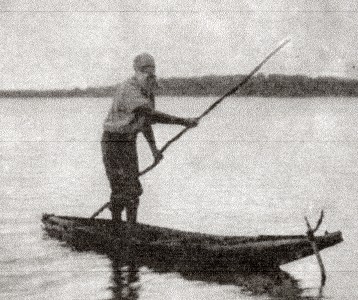 |
 Plate XI, Figure 5. Bark Canoe of the
Anula Tribe.
Figs. 2-5 Spencer, W. B., and Gillen, F. J., The Northern Tribes of Central Australia, London, 1904. Reproduced by the courtesy of Messers. McMillan and Co. |
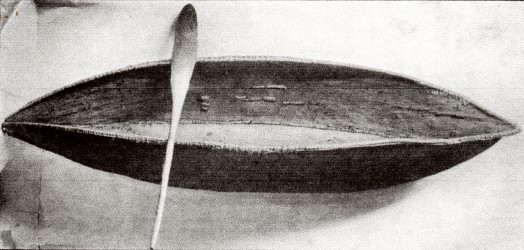 |
Plate XII, Fig. 2. Bark Canoe, Port Denison, Queensland. Museum f. Volkerkunde, Berlin. [Dr. von Luschan] |
Plate XI, Fig. 4.
Tied End Bark Canoe, N.S.W. |
 |
Fig. 2. Bark canoe in Pitt Rivers Museum, Oxford. [Mr. Henry Balfour |
 |
| District. |
Dimensions. |
Capacity. |
| Victoria |
7' 6" (2-3 m.) |
2 men |
| Victoria #2 |
8' (24 m.) | 3 men |
| Victoria #3 |
10' - 12' (3 m. - 3.7m.) |
4 men |
| Bangerang | 18' x 2.5' x 8'' (5.5 m. x 76 cm. 20 c m.) | 5 men |
| The Moira | 20' (6 m.) |
5 - 6 men. |
| Gippsland | ..... | 6 - 10 men. |
| New South Wales | 12' (3.6 m.) | bullock plough |
| NSW, Murray |
large | boxes, etc. |
| Murray #2 |
15' x 3' x 8" (4-5 m. x 90 cm. x 20 cm.) | 7 - 8 men. |
| Murray #3 |
14' (3.6 m.) | 4 men. |
| Murray #4 |
? | 2 men. (5 as ferry). |
| Murray #5 |
? | 3 men. |
| District. |
Dimensions.
|
Capacity. |
| New South Wales, Lake Macquarie | ..... |
9 men. |
| New South Wales, Wellington Dist. | 6' x 2.5' (1.8 m. x 76 cm.) |
2 men. |
| Port Denison | 9' (2.76 m.) | .... |
| Queensland, Saltwater Bay (18° 50') | 8' (2.4 m.) | 2 men. |
| Queensland (18° 10') | 5' (1.5 m.) | 2 men. |
| Queensland (17° 58') | 5' x 1.5'
(l.5 m. x 45cm.) |
1 or 2 men. |
| Queensland,
Endeavour River |
..... | 1 or 2 men. |
| District. | Dimensions. |
Capacity. |
| M. Island (20° 48') | 8' x 3.5' x
20'' (2.4 m. x 1.06 m. x 50cm.) |
.... |
| 16° S. :136°E. | ? x 2' (60 cm.) | .... |
| 16° S.
:136°E. #2 |
? ? |
4—5 men. |
| 13° 15' S. : 136° E | 13.5' x 2.5' (4.12 m. x 76 cm.) | 6 men. |
| Anula Tribe | 17'x 2' (5.2
m.x 60cm.) |
6—8 men. |
| Port Essington | 20' (6 m.) | ...... |
| Port Essington #2 | 18' x 2' (5-5 m. x 60 cm.) | 8 men. |
| Adelaide
River |
15' x 2' (4-5 m. x 60 cm.) | ..... |
 |
Plate XI, Figure 8. Dug-out Canoe, Wessel Islands. [Royal Geographical Society] |
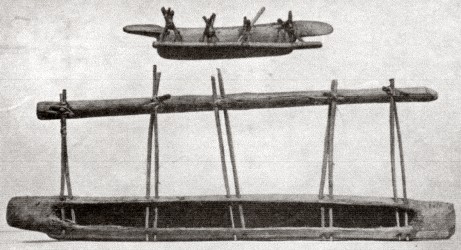 |
Plate XII, Figure 1. Outrigged Canoe, Cairns District, Queensland. British Museum
|
|
[District,]
|
Dimensions, | capacity. |
|
Cape York
|
15' - 20' (4.6 - 6 m.) | ...... |
|
Cape York #2
|
45' x 3'
(13.6 m. x 91 cm.) |
...... |
|
Newcastle Bay
|
28' x 2.5' (8.5 m. x 76 cm.) | ...... |
|
Newcastle Bay #2
|
50'
(15.2 m.) |
12 - 15 men |
|
Bird Island
|
16'- 18' (4.9 - 5.5 m.) | ...... |
|
Cape Direction
|
20' (6 m.) | ...... |
|
Cape Flinders and
|
19' x 22" (5.7 m. x 55 cm.) | ...... |
|
Endeavour River.
|
10' (2-7 m.) | 4 men |
|
Weary Bay
|
21' x 15" (6") (6-3 m. x 37 cm.) | ...... |
|
? ? (Cook)
|
14' (4-1 m.) | ...... |
 |
Plate XI, Figure 6.
Log-rider, Rosemary Islands, N.W. Australia. |
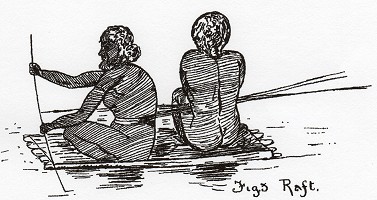 |
Plate XI, Figure 3. Raft, N.W. Australia. |
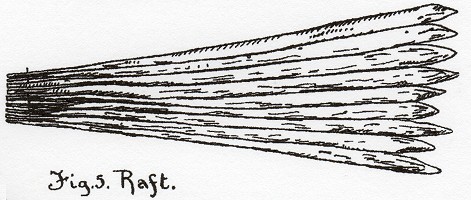 |
Plate XI, Figure 5. Triangular Raft, Roe's Group, N W. Australia. |
| Place or Tribe. | Name |
| 10. Nichol Bay |
yowarda. |
| 15. Champion Bay | kewardie. |
| 24. Geographic Bay | kibera. |
| 48. Cooper's Creek [1] | uko bichi. |
| 50. Cooper's Creek
(near Bulloo) |
ngumboo. |
| 53. Lower Bulloo [1] | boorlee. |
| 55. Dieri [1] | pirra |
| 63. Gawler
Range [1]
|
yoota. |
| 65. Mount Remarkable [1] | youkou. |
| 67. Yorke's Peninsula | jukkoo. |
| 68. Adelaide | bokka ( = bark) yoko
(yoko=bark at Cooktown). |
| 69a. N.W. Corner of New South Wales [2] | pulturoo. |
| 90. Burketown
(17° 30' S., 139° 40' E.) |
kamera. |
| 92. Mouth of Norman | nye. |
| 93. Midde | orukkw |
| 99. Cloncurry | nungkore. |
|
153. Barcoo [2] |
wogara. |
| 154. Barcoo | doombahcng, |
| 155. Barcoo | weeier, tangiri,
oorun. |
| Place or Tribe. | Name. |
| 1. Port
Darwin |
gunoogara |
| 2. Woolna (Adelaide Biver) | maltigia moerty. |
| or Limba Karadja (Port Essington) | lippee-lippee. |
| 3. Unalla (Baffles Bay) | oboen. |
| Place or Tribe. | Name. |
| 7. Ghidang (C. York) | angania. |
|
108. P. Charlotte's Bay |
tandi. |
| 109. Endeavour Biver |
marigau,
marigan. |
| 110. Weary Bay | berongaboy. |
| 116. Head of Walsh | murregan. |
| Wang-ga | canoe. |
| Barman | outrigger (? float). |
| Bantchau | body. |
| Wakka | bow. |
| Gorumon | stern. |
| Kanna-kanna | crosspieces. |
| Tabiul |
boom. |
| Yirinbar | two washboards locked on gunwale |
| Biribe | paddle |
| Place or
Tribe. |
Name |
| 75. Bourke, Darling River | bultdru (tulkaru = bark). |
| 76.
Fifty miles lower |
bulyunga. |
| 78. Tintinaligi, Darling River | butherop (baltha=bark). |
| 79. Weinteriga | pulteru (palta=bark). |
| 80. Menindie | pulteru
(palta=bark) |
| 82. Marowera, Murray River | pulteru (palta=bark), bankoom. |
| 83. Pytu Reach | meralti. |
|
84. Wellington |
manno. |
| 85. N.W. bend of | manno. |
| 86.
Ned's Corner |
munga. |
| 87. Kemendoh | longup. |
| 88. Yittha | yongni, kokvmnk. |
| [Place or
Tribe.] |
[Name] |
| 118. Hinchinbrook Island | woolgo. |
| 119. Herbert River | woolgo. |
| 120. Halifax Bay | woolgo. |
| 124. Cleveland Bay | oolgaroo. |
| 124. Cleveland Bay | wooroo. |
| 125. Mount Elliot | woolgoora. |
| 126. Mouth of Burdekin | karbeyal. |
| 131.
Cape River |
kooga. |
| 133.[1] Mount Black | oolkooroo. |
| 134. Lake Burdekin | kobbetheba. |
| 134. Lake Burdekin | bettel-bettel. |
| 136. Port Denison | vinda. |
| 143. Belyando River
|
warella. |
| 143.
Belyando River |
balgoo. |
| Place or
Tribe. |
Name. |
| 145.
Aminungo |
winda. |
| 147, 148. Port Mackay, Broad Sound | winda. |
| 149. Rockhampton | andool. |
| 150.
Lake Dawson, etc. |
iandool. |
| 153.
Barcoo, see Table I. |
|
| 156. Nogoa Biver | weanda. |
| 157. Comet River | kooga (=bark). |
| 158. Brown River | kooga (=bark). |
| 159. Dawson River | boonde. |
| 159. Dawson River | gundoa ( = bark). |
| Burnett River | goondu (=bark). |
| 161. Boyne River | kooga. |
| 163. Baffle Creek | kundole. |
| 164.
Moreton Bridge (N. side) |
kumba (=bark). |
|
Maryborough
|
kolaro. |
|
Near Brisbane
|
kumbar (=bark). |
|
Eraser's Island
|
kooloro. |
| 165. Upper Burnett | kundool. |
| 166.
Kabi |
kombar (cf. 164). |
|
167. Upper
Brisbane |
koondoo
(=bark). |
| 168. TurHbul |
koondoo (=bark). |
| 169. Condamine | kundung (tundo=bark).
|
| 170,171. Stradbroke Island | koondool
(koonjool=bark) |
| 172. Berang Creek, etc | .... |
| 170. Moreton Island | oobum. |
| [Place
or Tribe] |
[Name.] |
| 175. Balonne River |
boondurra. |
| 176. Bigambul |
gillee (=bark), welbon. |
| 177.
Mungalella Creek |
kooka. |
| 178.
Richmond River |
burcool. |
|
Ballina, etc
|
kindul. |
| 180. Queenbulla | walkia. |
| 181. Namoi | kumbilgal. |
|
Namoi
|
wyardka. |
| 182. Culgoa | toongoon (=bark). |
| 183. Wailwum | mungar. |
| 184 Clarence River | bakool, wolloo. |
| 185. Lake Macleay | woi. |
| 187. Manning River | kooyauk (koorak =
bark). |
| 188. Hunter River | buba. |
| 189. Hawkesbury River | nooia. |
| 190. Warren, New South
Wales sBathurts |
murrin
(=bark); war gin. warrwag (doorong=bark). |
|
Bathurst
|
kogee. |
| Place or Tribe | Name. |
|
Bogan River
|
mure. |
|
Deniliquin
|
koonadan. |
| 191. Port Jackson | nowey. |
| 192. Botany Bay | yernera. |
| 193. Shoalhaven | yernera, mudyeri. |
| 194. Jervis Bay | kurridja. |
|
196. Queanbeyan |
murring. |
| 197. Moneroo | mamat. |
| 199. Swan Hill | unkooi. |
| 201. Piangil | yungobi. |
| 202. Burnbang, Murray River | longoi. |
| 204.
Tatiarra |
yongoe. |
| 205.
Mount Gambier |
wola, bem, woggo.[1] |
| 207A. Lake
Hindmarsh |
yoongooip. |
| 207C. Upper Glenelg | torong (~=bark). |
| 207D. Glenelg | ngnanak (=bark). |
| 207E. Woodford | wowwo. |
| 207G. Hamilton | yaongalo. |
| 207H. Mount Rouse | yowargalooh. |
| 207I. Lake Condah | tholong |
| 207J. Hopkins River | torong (=bark). |
| 208A. Moulmein | yungwitch. |
| 208B. Lake Boga | yungoot. |
| 208J. Moorabool | korong, yaoot. |
| 209A. Ngooraialum, etc. | korom. |
| 210. Gippsland | gre, yuro. |
| 211. Omeo | worbang (worogang=bark). |
| 213. Upper Murray | moutha. |
| 214. Bangerang, etc | mattha, matta. |
| bootjo. |
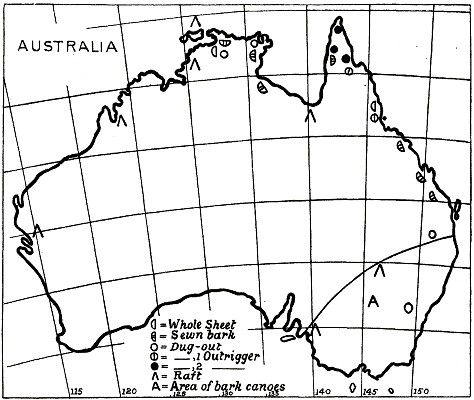
Plate
X  |
Fig. 1. Kurnai, Bark Canoe, Victoria. Howitt, The Native Tribes of South-East Australia, London, 1904, page 424. (cropped) Fig. 4. Paddle |
 |
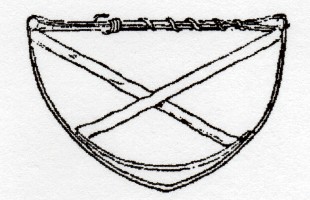 |
Fig. 2. Cross Section
Fig. 3. Bow
|
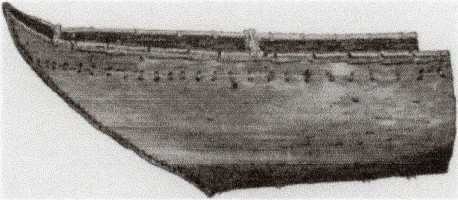 |

Plate XI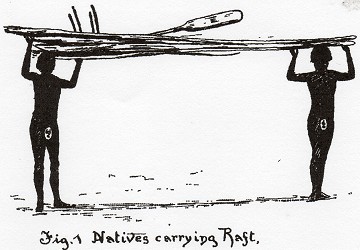
Figs. 1 and 2. King's Sound.
[Mrs. Savile Kent] |
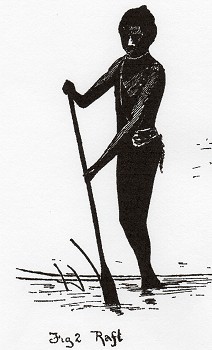 |
 |
 Fig. 4. N.S.W.
Fig. 3. N.W. Australia. |
 Fig. 5. Roe's Group, N W. Australia. Fig. 6. Rosemary Islands, N.W. Australia.
|
 |
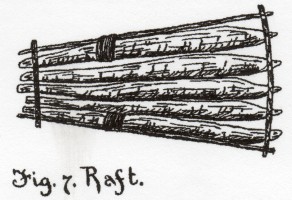 |
 Fig. 8. Wessel Islands.
[Royal Geographical Society] |
|
FlG. 1. Outrigged Canoe, Cairns District, Queensland. British Museum |
. 
|
Fig. 2.Bark Canoe,
Port Denison, Queensland. Museum f. Volkerkunde, Berlin. [Dr. von Luschan] |
 |
| Thomas, N. W.: Australian
Canoes and Rafts The Journal of the Anthropological Institute of Great Britain and Ireland Royal Anthropological Institute of Great Britain and Ireland Vol. 35 (Jan. - Jun., 1905), pages 56-79 Stable URL: http://www.jstor.org/stable/2843117 Accessed: 09/11/2010 22:25 |
|
|
|
|
|
|
|